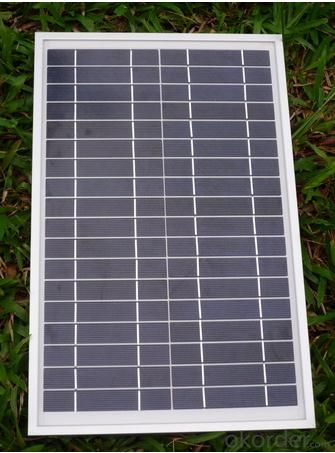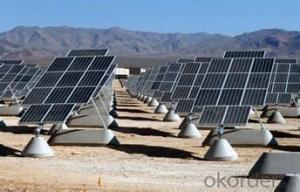15KW Solar Home Solution with 25 years Qualtiy Assurance
- Loading Port:
- Shanghai
- Payment Terms:
- TT OR LC
- Min Order Qty:
- 1 pc
- Supply Capability:
- 5000 pc/month
OKorder Service Pledge
OKorder Financial Service
You Might Also Like
Item specifice
15KW Solar Home Solution with 25 years Qualtiy Assurance
Production description
a solar array only encompasses the ensemble of solar panels, the visible part of the PV system, and does not include all the other hardware, often summarized as balance of system (BOS). Moreover, PV systems convert light directly into electricity and shouldn't be confused with other technologies, such as concentrated solar power or solar thermal, used for heating and cooling.

Feature
1.High conversion efficiencies resulting in superior power output performance.
2.Outstanding power output even in low light or high temperature conditions
3.Optimized design for ease of soldering and lamination
4.Long-term stability,reliability and performance
5.Low breakage rate
6.Color uniformaity
Physical characteristic
1. Rigorous quality control meets the highest international standards.
2. High-transmissivity low-iron tempered glass, strong aluminium frame.
3. Using UV-resistant silicon.
4. IS09001/14001/CE/TUV/UL
- Q:Can a solar energy system be integrated with energy storage systems?
- Yes, a solar energy system can be integrated with energy storage systems. In fact, this integration is becoming increasingly popular and important in the renewable energy sector. Energy storage systems, such as batteries, allow excess energy generated by solar panels to be stored for later use when the sun is not shining or during periods of high demand. This helps to address the intermittent nature of solar energy production and ensures a more reliable and continuous power supply. By combining solar energy systems with energy storage, users can reduce their reliance on the grid, increase self-consumption of solar energy, and even achieve complete energy independence in some cases. Moreover, this integration is crucial for the advancement of sustainable and resilient energy systems, as it enables the integration of renewable energy sources into the grid and smooths out fluctuations in energy supply and demand.
- Q:Can solar energy systems be used for powering off-grid humanitarian missions?
- Yes, solar energy systems can be used for powering off-grid humanitarian missions. Solar energy is a reliable and sustainable source of power that can be harnessed in remote locations where grid electricity is not available. By installing solar panels and associated equipment, such as batteries and inverters, humanitarian missions can generate electricity to meet their energy needs, powering lights, communication devices, medical equipment, and more. Solar energy systems offer a cost-effective and environmentally friendly solution, enabling these missions to operate independently and effectively in off-grid areas.
- Q:Can solar panels be installed on different surfaces like glass or metal?
- Yes, solar panels can be installed on different surfaces like glass or metal. In fact, solar panels are commonly installed on rooftops, which are often made of materials like glass, metal, or asphalt shingles. The most common type of solar panels, known as photovoltaic (PV) panels, are designed to be mounted on a variety of surfaces. The installation process involves securing the panels to the surface using racks or frames, ensuring that they are properly angled to maximize sunlight exposure. Whether it is a glass or metal surface, solar panels can be installed and effectively generate electricity from the sun's energy.
- Q:What is the impact of roof color on the performance of solar panels?
- The impact of roof color on the performance of solar panels is minimal. While darker roofs may absorb more heat, they do not significantly affect the overall efficiency or output of solar panels. The performance of solar panels primarily depends on factors such as the angle and orientation of the panels, the presence of shading, and the quality of the solar cells themselves.
- Q:Are there any risks of electrical grounding issues with solar energy systems?
- Solar energy systems can pose several risks due to electrical grounding issues. One major risk is the potential for electric shock, which occurs when the grounding system is not correctly installed or maintained. This can cause a buildup of electrical current, leading to contact with live electrical components and subsequent shock. Another risk is the possibility of fire. When the grounding system is improperly installed, it can result in electrical arcing, which can ignite a fire. This is especially hazardous as solar energy systems are often situated on rooftops, making it easier for a fire to rapidly spread throughout the entire building. Furthermore, a faulty grounding system can cause damage to the solar energy system itself. Without proper grounding, electrical surges and fluctuations can occur, harming sensitive components like inverters and batteries. To mitigate these risks, it is essential to ensure the proper installation and regular inspection and maintenance of the grounding system in a solar energy system. This involves using appropriate grounding equipment like grounding rods or conductors, as well as ensuring all connections are secure and free from corrosion. Regular testing should also be carried out to assess the effectiveness of the grounding system. It is advisable to enlist the services of a qualified professional for the installation and maintenance of the grounding system to minimize the hazards associated with electrical grounding issues in solar energy systems.
- Q:How do solar energy systems impact the electricity grid?
- Solar energy systems can have a positive impact on the electricity grid by reducing the demand for traditional fossil fuel-based electricity generation. As more solar power is generated and fed into the grid, it helps to diversify the energy mix and decrease the reliance on non-renewable sources. Additionally, solar energy systems can help alleviate peak demand periods, especially during sunny days, leading to a more stable and reliable grid. However, the intermittent nature of solar power can also pose challenges for grid operators in terms of managing fluctuations and ensuring grid stability.
- Q:Can a solar energy system be installed in areas prone to hailstorms?
- Yes, solar energy systems can be installed in areas prone to hailstorms. However, it is essential to consider certain factors to ensure their durability and resilience against hail damage. This includes using high-quality materials, such as tempered glass for solar panels, and proper installation techniques. Additionally, some solar panels are specifically designed to withstand hail and extreme weather conditions, providing further protection.
- Q:Can solar energy systems be used in remote areas without access to the power grid?
- Yes, solar energy systems can definitely be used in remote areas without access to the power grid. Solar panels can be installed to capture sunlight and convert it into electricity, which can then be used to power homes, businesses, or any other electrical needs. These systems are particularly beneficial in remote areas as they offer a sustainable and reliable source of energy, reducing dependence on traditional power grids and increasing energy independence. Additionally, advancements in battery storage technology allow excess solar energy to be stored and used during nighttime or cloudy days, ensuring a continuous power supply even in these areas.
- Q:Can solar energy systems be used in commercial agriculture?
- Yes, solar energy systems can be used in commercial agriculture. Solar panels can be installed on agricultural buildings or in open fields to generate clean and renewable energy. This energy can power various agricultural operations such as irrigation systems, crop drying, and greenhouse heating. Solar energy systems offer cost savings, reduce reliance on fossil fuels, and contribute to sustainable farming practices.
- Q:What is the role of trackers in a solar energy system?
- Trackers play a crucial role in a solar energy system by optimizing the efficiency and output of solar panels. These devices are designed to track the movement of the sun throughout the day and adjust the position of the solar panels accordingly. By continuously orienting the panels towards the sun, trackers ensure that they receive maximum sunlight, resulting in increased energy production. The primary function of trackers is to maximize the solar energy captured by solar panels by maintaining their optimal angle relative to the sun. This is achieved through the use of sensors, motors, and control systems that enable the tracker to follow the sun's path from east to west. By continuously adjusting the panel's position, trackers can ensure that the sunlight hits the panels at a perpendicular angle, optimizing the amount of solar radiation absorbed. Trackers are particularly beneficial in locations with high variations in sunlight intensity throughout the day or across different seasons. By actively tracking the sun's movement, trackers can compensate for these variations and maintain a consistent level of solar energy production. This is especially important in regions with pronounced seasonal changes, as it allows solar panels to capture sunlight at the most effective angle year-round, maximizing their overall energy output. Furthermore, trackers can help improve the overall economics of a solar energy system. By increasing the efficiency of solar panels, trackers can generate more electricity from the same surface area. This means that fewer panels are required to produce a given amount of energy, reducing the overall cost of the system. Additionally, trackers can increase the return on investment by maximizing the energy output and reducing the payback period of the solar installation. In conclusion, the role of trackers in a solar energy system is to optimize the performance and efficiency of solar panels by continuously adjusting their position to face the sun. By maximizing the amount of sunlight captured, trackers enhance energy production, improve the economics of the system, and ensure a consistent level of solar energy generation throughout the day and across different seasons.
1. Manufacturer Overview |
|
|---|---|
| Location | |
| Year Established | |
| Annual Output Value | |
| Main Markets | |
| Company Certifications | |
2. Manufacturer Certificates |
|
|---|---|
| a) Certification Name | |
| Range | |
| Reference | |
| Validity Period | |
3. Manufacturer Capability |
|
|---|---|
| a)Trade Capacity | |
| Nearest Port | |
| Export Percentage | |
| No.of Employees in Trade Department | |
| Language Spoken: | |
| b)Factory Information | |
| Factory Size: | |
| No. of Production Lines | |
| Contract Manufacturing | |
| Product Price Range | |
Send your message to us
15KW Solar Home Solution with 25 years Qualtiy Assurance
- Loading Port:
- Shanghai
- Payment Terms:
- TT OR LC
- Min Order Qty:
- 1 pc
- Supply Capability:
- 5000 pc/month
OKorder Service Pledge
OKorder Financial Service
Similar products
New products
Hot products
Hot Searches
Related keywords






























